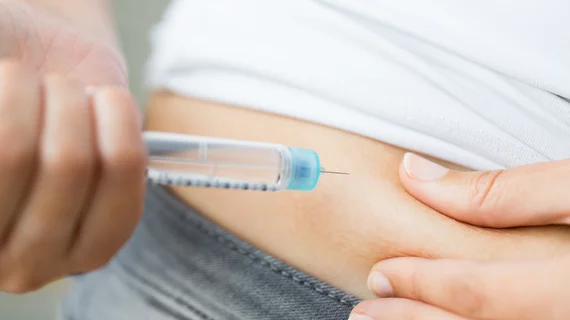25% of diabetics skimp on insulin because of cost
As insulin prices in the U.S. continue to surge, lower-income diabetics are struggling to afford a drug their life depends on, researchers report in a JAMA Internal Medicine study published Dec. 3.
The study, authored by Darby Herkert, BS, and colleagues at the Yale School of Medicine, involved surveying 199 patients about the affordability of their medication and the likelihood that they’d skimp on insulin to cut costs. Subjects were 51 percent female, 61 percent white and 42 percent type 1 diabetics, and Herkert’s team considered insulin “underuse” as taking less insulin than prescribed, trying to “stretch out” insulin doses, failing to fill insulin prescriptions or stopping use altogether due to cost.
Of the diabetics surveyed, more than 25 percent admitted they’d compromised their insulin regimen to save money—a result that generated considerable buzz after Herkert et al. initially presented their findings at the American Diabetes Association’s annual conference in June. While patients’ type of prescription drug coverage wasn’t linked to underuse, a lower income was.
Nearly 40 percent of lower-income patients said they hadn’t discussed the cost of insulin with their clinician, and 15 percent changed insulin type due to prices. In multivariable analysis, participants who reported cost-related insulin underuse were more likely to have poor glycemic control (43.1 percent compared to 28.1 percent of regular-use patients).
“If there is one fact that should cause national embarrassment, it is the high price tag we affix to living with type 1 diabetes,” Elisabeth Rosenthal, MD, a longtime physician and New York Times reporter, wrote in a letter published simultaneously in JAMA.
“People with type 1 diabetes are people who drew the short straw in the disease lottery,” she said. “The U.S. insurance system—private and public—does not cut people with chronic disease a break but instead tends to penalize them.”
She said that while skimping on medications is never a great idea, it’s not catastrophic for many diseases. But taking insulin isn’t like taking blood pressure pills—patients can’t self-correct if they miss a couple of doses.
Rosenthal wrote the U.S. is trailing other developed countries in its adoption of affordable insulin. She said for-profit drug and device manufacturers have spent millions filing lawsuits to keep cheaper competitors off the American market, and because of that, an insulin pen that retails for less than $15 in Germany and Canada costs $140 in the U.S.
“People with type 1 diabetes are both beneficiaries and pawns in the business ventures of drugmakers, device manufacturers and insurers, and sometimes these companies seem willing to sacrifice a pawn or two for profits,” Rosenthal wrote. “Today people with type 1 diabetes are again at an increased risk of becoming ill and even dying prematurely because of the price.”
Despite recent deaths, the problem isn’t getting any better. Patients are dealing with unaffordable insulin—the monthly wholesale cost of Humulin, the country’s most popular insulin, jumped from $258 to $1,100 between 2010 and 2015—and Herkert’s team found that two-thirds of lower-income patients can’t even afford the diabetes equipment they need.
“Extreme prices can lead to extreme solutions,” Rosenthal wrote. “That 25 percent will quietly skimp on their insulin, taking less than they need but more, perhaps, than they can afford. Some of them will die.”

